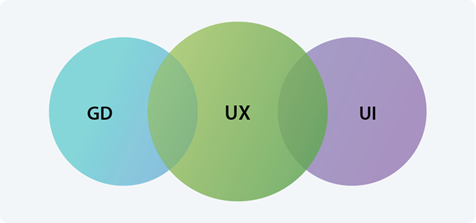With the evolution of technology and digital platforms, the demand for the design industry has rapidly grown. From the initial design evolution, the phrase ‘Design’ reminds people of Graphic Design, but there is a lot of confusion with the design designations trending around. We would like to simplify and explain the differences between Graphic Design, User Interface Design, and User Experience Design.
It is very common to get confused even for the designers who have come from different industries. At present there are several new design job titles that have evolved with the vast expansion of the tech industry. With the growth of technology, the design industry has also evolved from print media to the web, mobile and soft-wares.
Let’s start with some basic definitions to clear your confusions and give you simpler examples before we go deeper into the confusion 😉
- Graphic Design (GD)
- User Interface Design (UI)
- User Experience Design (UX)

GD, UI and UX terminologies are related, yet have very different processes and outcomes. But in today’s evolving software engineering teams these are often confused and used as being the same job roles.
“Each color lives by its mysterious life.”
— Wassily Kandinsky, Painter
1. Graphic designer
The elementary role of the graphic designer is in presenting and communicating messages with a visual representation. In general, graphic designers work on “Branding” and “Visual Identity” gets inputs and directions from the creative team or marketing team of the company. To simplify the role of a Graphic Designer is all about creating graphics, brand identity, visual concepts for both on-screen and print media. Their job is to make something that not only looks good but also serves its business goals and create a WOW effect. These are some of the elements used to create visual content by Graphic Designers: Typography, Images, Shape, Color, and Layout.
“There are three responses to a piece of design – yes, no, and WOW! Wow is the one to aim for.”Milton Glaser
Graphic designer’s specific work will fall under designing the following:
- Marketing collaterals
- Branding materials
- Logo designing
- Social media promotions
- Infographics
- Website mockups etc..
2. User Interface Designer (UI)
User interface designers are responsible for designing the graphical outline/layout of a website or an application and appealing aesthetics. UI designers are graphic designers who are more concerned with the aesthetics of the design. It’s up to them to make sure the application’s interface is attractive, visually-stimulating, and themed appropriately to match the purpose and personality of the app. And they are responsible for making make sure every single visual element is cohesive, both aesthetically, and in purpose. They are more responsible for creating visually pleasing, simple, and efficient screens of the product framework and wireframes created by the UX designer and translates them into high-fidelity prototypes, final visual deliverables before sending them to an engineering or development team.“If a picture is worth 1000 words, a prototype is worth 1000 meetings.”David & Tom
UI designers specific work fall under creating the following:
- Visually appealing screens
- Style Guides (Colors, Typography, Iconography, Buttons, Input Controls, Navigational Components, Illustrations, and Images, etc.…)
- Ensure consistency in design
- High fidelity prototypes
3. User Experience Designer (UX)
UX designers are completely responsible for building and designing complete ‘user experience’ quality between the product and user, be it an application, website, or a physical product. UX designers are focused on solving the problems based on the user’s journey. This had to be performed in two different stages labeled as “research” and “validation”.“Design is not just what it looks like and feels like. Design is how it works.”Steve Jobs
UX designers mainly deliver, prototypes, site maps, wireframes, flows, data, content, and research documentation. While doing the research, the UX designers use different tools, approaches to better understand their users, and responsible for the progression of making a product/service useful.
UX designers accomplish usability/pain point analysis to define if the product is generating the required results. Best practices of UX designer is similar to a design thinking approach:
- Research and documentation of the product
- Competitive analysis
- User personas
- Information Architecture
- Empathy mapping
- User flows
- Wireframes
- Usability testing and solving user problems
- End to end experiences
Conclusion
GD, UI, and UX are different but interrelated. Graphic design is a subcategory of User Interface design and UI is the subcategory of User Experience design. But the main thing that differentiates UX Designers apart is the user-centered approach and how they validate their solutions with the end-users so that both user and business needs are being met.“Everything that needs to be said has already been said. But, since no one was listening, everything must be said again.”Andre Gide
Hope we have cleared the confusion, Thank you.




